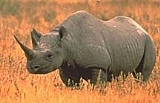
Rhinoceros
Overview
Rhinoceros also known as rhino, is a group of five extant species of odd-toed ungulate
s in the family
Rhinocerotidae. Two of these species are native to Africa
and three to southern Asia
.
The rhinoceros family is characterized by its large size (one of the largest remaining megafauna
), with all of the species able to reach one tonne
or more in weight; an herbivorous
diet; a thick protective skin, 1.5–5 cm thick, formed from layers of collagen
positioned in a lattice
structure; relatively small brains for mammals this size (400–600 g); and a large horn.
Odd-toed ungulate
An odd-toed ungulate is a mammal with hooves that feature an odd number of toes. Odd-toed ungulates comprise the order Perissodactyla . The middle toe on each hoof is usually larger than its neighbours...
s in the family
Family (biology)
In biological classification, family is* a taxonomic rank. Other well-known ranks are life, domain, kingdom, phylum, class, order, genus, and species, with family fitting between order and genus. As for the other well-known ranks, there is the option of an immediately lower rank, indicated by the...
Rhinocerotidae. Two of these species are native to Africa
Africa
Africa is the world's second largest and second most populous continent, after Asia. At about 30.2 million km² including adjacent islands, it covers 6% of the Earth's total surface area and 20.4% of the total land area...
and three to southern Asia
Asia
Asia is the world's largest and most populous continent, located primarily in the eastern and northern hemispheres. It covers 8.7% of the Earth's total surface area and with approximately 3.879 billion people, it hosts 60% of the world's current human population...
.
The rhinoceros family is characterized by its large size (one of the largest remaining megafauna
Megafauna
In terrestrial zoology, megafauna are "giant", "very large" or "large" animals. The most common thresholds used are or...
), with all of the species able to reach one tonne
Tonne
The tonne, known as the metric ton in the US , often put pleonastically as "metric tonne" to avoid confusion with ton, is a metric system unit of mass equal to 1000 kilograms. The tonne is not an International System of Units unit, but is accepted for use with the SI...
or more in weight; an herbivorous
Herbivore
Herbivores are organisms that are anatomically and physiologically adapted to eat plant-based foods. Herbivory is a form of consumption in which an organism principally eats autotrophs such as plants, algae and photosynthesizing bacteria. More generally, organisms that feed on autotrophs in...
diet; a thick protective skin, 1.5–5 cm thick, formed from layers of collagen
Collagen
Collagen is a group of naturally occurring proteins found in animals, especially in the flesh and connective tissues of mammals. It is the main component of connective tissue, and is the most abundant protein in mammals, making up about 25% to 35% of the whole-body protein content...
positioned in a lattice
Crystal structure
In mineralogy and crystallography, crystal structure is a unique arrangement of atoms or molecules in a crystalline liquid or solid. A crystal structure is composed of a pattern, a set of atoms arranged in a particular way, and a lattice exhibiting long-range order and symmetry...
structure; relatively small brains for mammals this size (400–600 g); and a large horn.

